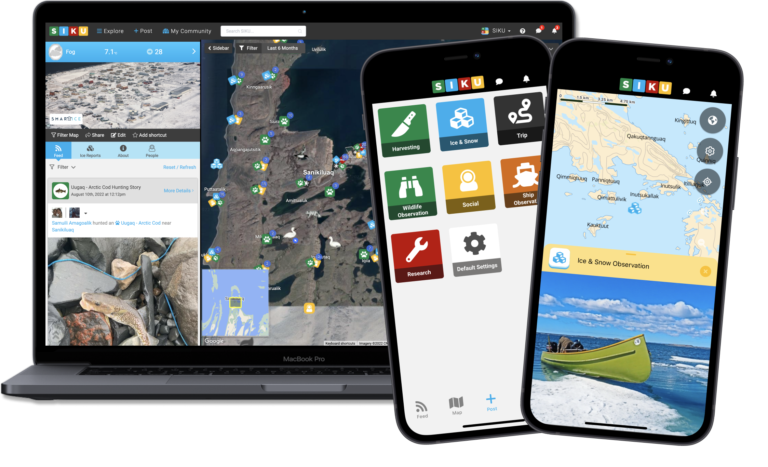SIKU
supports
research
with Indigenous communities
Photo from Arctic Eider Society
Post written by Christina Macdonald of the Arctic Eider Society. SIKU received support from MEOPAR’s Knowledge Mobilization Fund.
Greetings from the Arctic Eider Society! As COVID-19 safety precautions loosen and travel picks up, we hope your return to the field has been smooth (your dusty field gear still fits!) and that your research is going well. Our app, SIKU, can help!
SIKU: The Indigenous Knowledge Social Network is a mobile app and web platform by and for Indigenous people which provides tools and services for knowledge exchange, travel safety, and language preservation. SIKU’s project management features also support collaborative research between Indigenous communities and academics. Given SIKU’s roots in Inuit Nunangat, the tools and services on SIKU have an Arctic focus but, excitingly, use of the app is growing at lower latitudes and internationally and new features are being brought on in response to this interest.
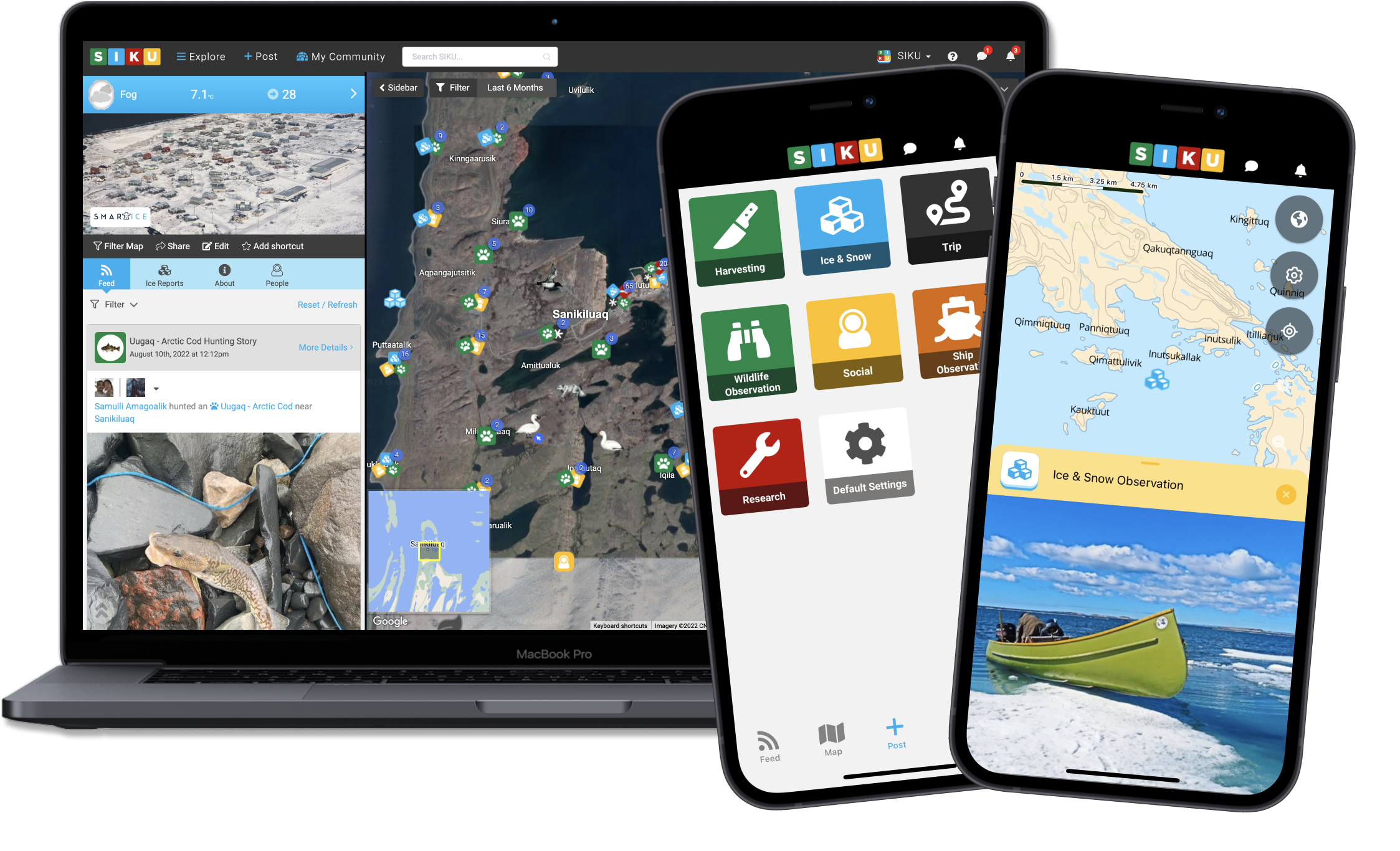
Over the past two years, the Outreach Team at the Arctic Eider Society (AES) has introduced ourselves virtually to many researchers in the MEOPAR network and learned about your projects and collaborations with northern community members and organizations. This work has been fueled by MEOPAR’s Knowledge Mobilization Fund. MEOPAR has recognized the role that SIKU can play in bringing people and perspectives together to enhance Canada’s research capacity in a changing marine environment. Input from academic researchers has been and continues to be key to SIKU’s growth and we are grateful for MEOPAR’s support.
Research Collaborations and the Launch of SIKU
One of AES’s early collaborations with academics (University of Manitoba, Carleton University, ArcticNet) involved working with the communities of Sanikiluaq (Nunavut), Inukjuak, Umiujaq, Kuujjuaraapik (Nunavik region of Quebec) and Chisasibi (Cree community in the Eeyou Marine Region of Quebec), and regional organizations to establish the Community-Driven Research Network (CDRN) in 2014. The CDRN is still going strong, with a focus on understanding large-scale cumulative impacts of environmental change and development projects affecting sea ice ecosystems in James Bay and Hudson Bay. Training is provided to local Inuit and Cree hunters to deploy oceanographic equipment and take ice core and water samples, continuing work that began through the Hudson Bay Programme and Voices from the Bay (1997).
The CDRN program was key to the development of SIKU; partners in the network helped test a prototype platform that allowed the results of salinity profiling, ice-core sampling and contaminants-monitoring to be shared. This prototype was highly successful in coordinating among communities and researchers, and led to the creation of the SIKU web platform and mobile app to facilitate knowledge sharing between Indigenous communities. With funding from the 2017 Google.org Impact Challenge in Canada and guidance from Inuit across the north, SIKU was launched in 2019 to broad acclaim.
Annie Eastwood
Field Scientist for Oceans North and Research Partner with Centre for Earth Observation Science, Coastal Oceanography Team, University of Manitoba:
“One of the many ways we use SIKU is to document where we travel around Sanikiluaq, what we are doing on the ice and the locations of our sampling. We also use SIKU to exchange sampling information; the local Inuit field team collects water samples and deploys CTDs and we are able to view the details of the trip on SIKU, including sampling data, from our offices in Winnipeg. Most importantly, SIKU has enabled our team to advance our outreach efforts, providing almost real time updates to the Hunters and Trappers Organization and community members about what we are doing on the ice.”
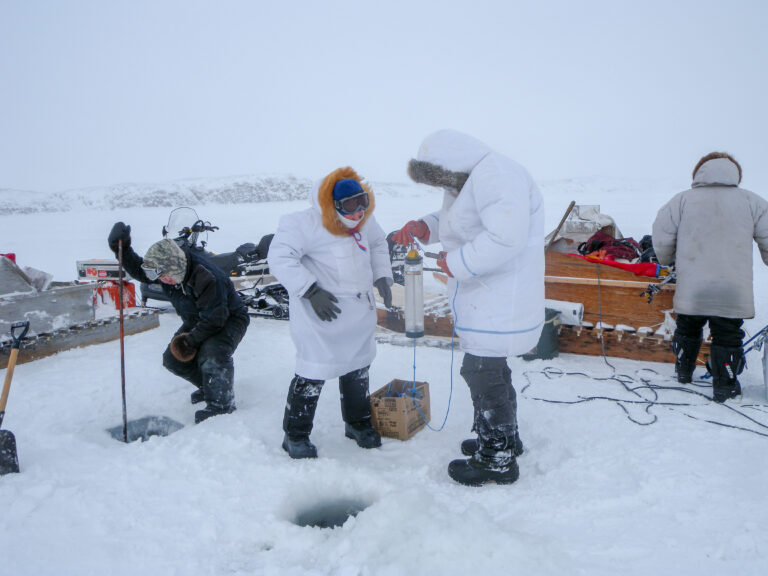
Photo from the Arctic Eider Society
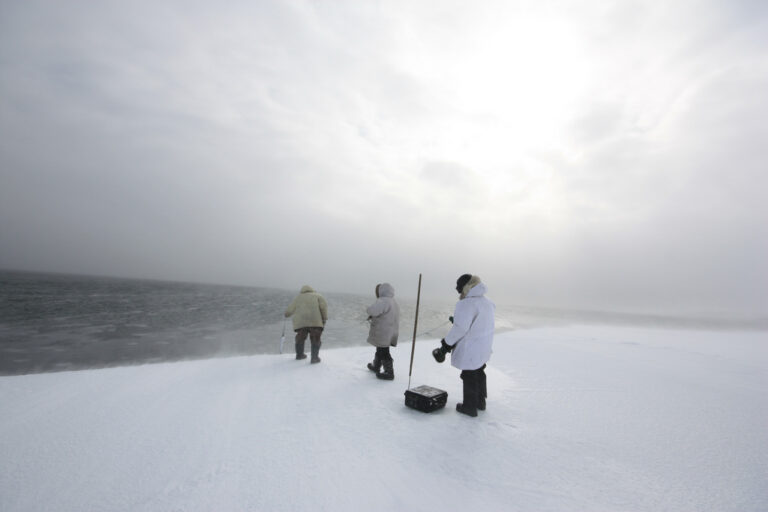
Photo from Jenn Provencher
MEOPAR supports SIKU’s Expanded Research Collaborations
Since its launch, SIKU has over 12,000 users and its evolution continues to be guided by priorities from Indigenous communities and regional organizations such as Inuit Tapiriit Kanatami’s National Inuit Strategy on Research (2018), which “targets governments, academia, and research institutions and identifies areas for partnership and action that can strengthen the impact, efficacy, and usefulness of Inuit Nunangat research for Inuit.”
Support from MEOPAR’s Knowledge Mobilization Fund has allowed the AES Outreach team to run SIKU training workshops for academic researchers. We have also partnered with several research teams to develop new features on SIKU that respond to the needs and priorities of northern communities. The results of these collaborations have been very positive!
Sharing Data for Community Safety
Working with a team from the University of Calgary, data from remote weather stations (including air temperature, and wind speed, gusts and direction) was made accessible in the SIKU app so local people have accurate information to inform their decision making in a rapidly changing climate.
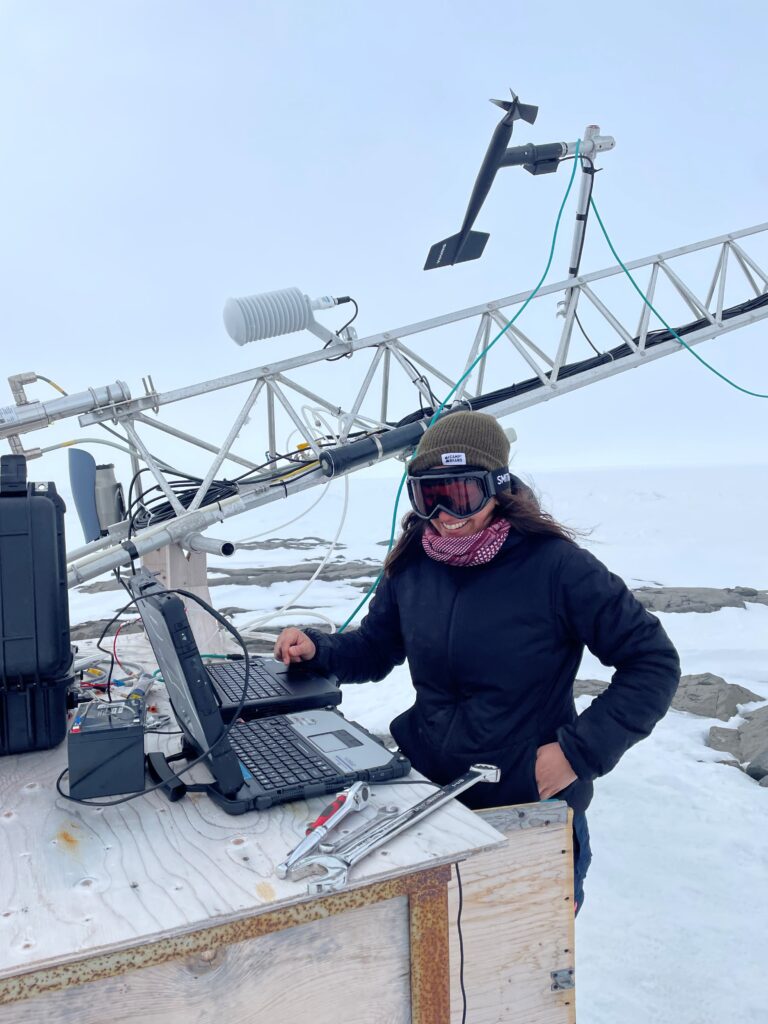
Calibrating instruments on the Qikirtaarjuk Island weather station, ~35 km southwest of Cambridge Bay, NU. Photo credit: Christina Braybrook 2022
Dr. Brent Else
Associate Professor, Department of Geography, University of Calgary:
“There are relatively few Arctic weather stations and air/ocean sensors maintained in the North, and fewer outside communities. Through interviews and discussion with communities in the Kitikmeot region of Nunavut, we know that access to weather information from key locations can be critical to local travel safety, search and rescue and decision-making.
Until recently, Inuit had to use multiple websites and download files in order to access weather, satellite, ice, and tidal information. Now, SIKU makes data from remote weather stations like those we support in the Kitikmeot region, available alongside ECCC weather information, ECCC sea-ice charts, tidal charts, sea-ice community-based monitoring (www.SmartICE.org), satellite imagery from ESA and NASA, and local observations made by Inuit. SIKU has provided a powerful and effective way to make relevant and valuable research data more accessible to communities.”
More Data Fields for Near Real-Time Monitoring
Working with members of a collective of researchers from different institutions called FISHES (Fostering Indigenous Small-scale fisheries for Health, Economy, and food Security), species specific measurement fields were added to SIKU’s wildlife profiles so that field data can be entered efficiently and accurately by both researchers and local experts and shared with all project members in near real-time to advance monitoring insights.
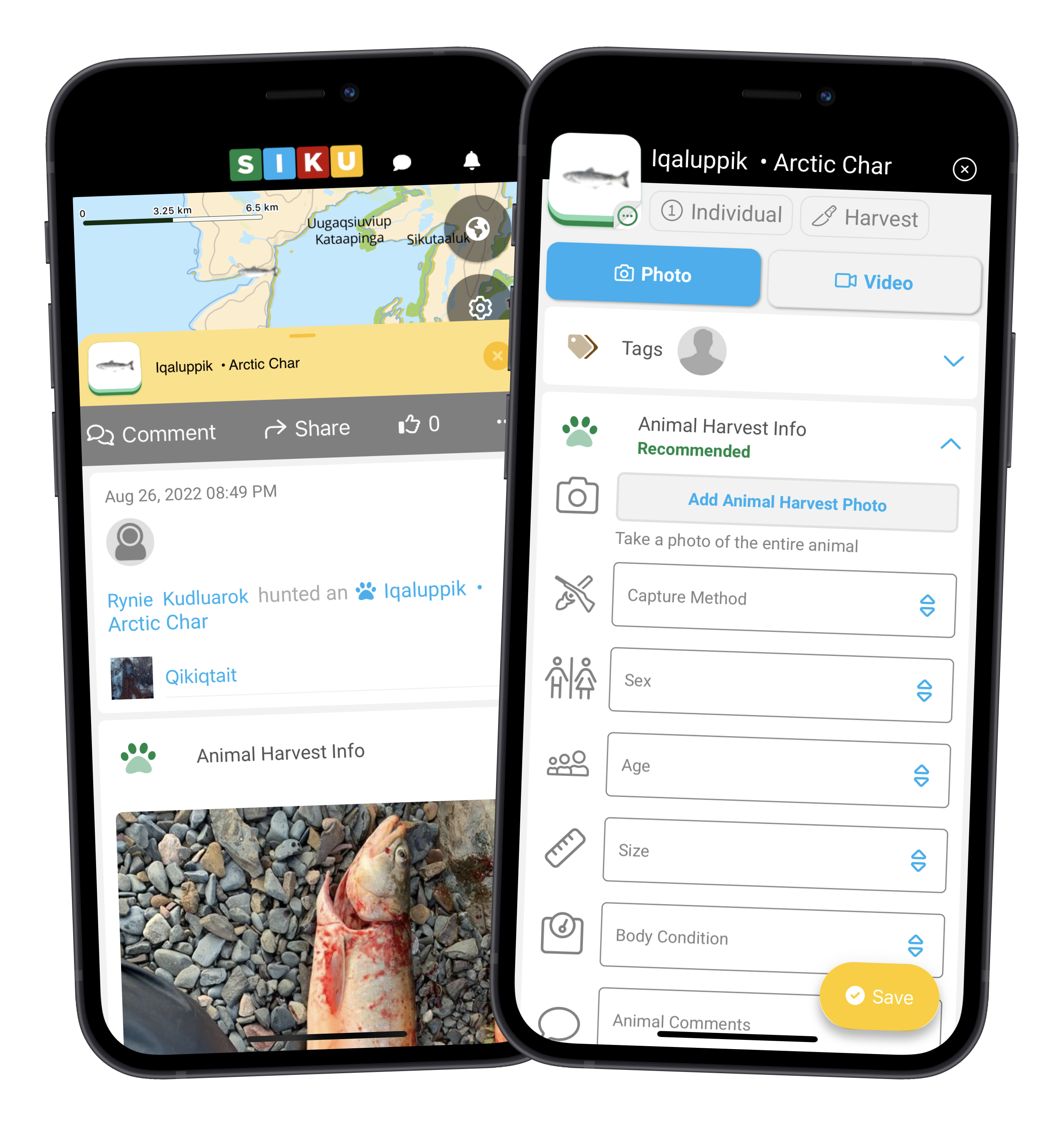
Emmelie Paquette
PhD Student, Carleton University:
“With the addition of the fish measurement tool, SIKU will be very helpful for the fish sampling program in Taloyoak and sharing information between researchers, the Government of Nunavut and community members. The user-friendly design, scalability and customizability of SIKU has the potential to improve fisheries management in Canada’s North.”
What’s Next?
Our discussions with researchers in the MEOPAR network and beyond have shown there is a high level of interest in using SIKU to share the results of research and to support collaborations with Indigenous people.
Indigenous people are already using SIKU in powerful ways, including to support protected area planning, operate community-driven projects, share ice safety information across Inuit Nunangat, and track the spring migration of geese from James Bay to Resolute Bay and from Nunatsiavut to the Inuvialuit Settlement Region.
As SIKU is increasingly integrated into research methodologies, the Outreach Team at AES looks forward to working with you to provide training and develop new features, including interoperability with other knowledge mobilization platforms, with the goals of supporting collaboration and increasing the impact and usefulness of research for Indigenous people.
Want to talk to someone from SIKU about how it can work for you? Send Christina an email.
SIKU Brochure for Researchers
Learn more about how to use SIKU for successful research projects.
